Mediterranean Mooring with an Anchor
This is the ultimate foredeck/helm communication exercise.
This method requires dropping the hook (anchor) out from the harbor quay wall at the appropriate place which is dependent on the depth. Then, the anchorperson feeds out the anchor chain as the helmsperson backs the boat to the quay. As the boat reaches the quay (a few feet (a meter) off) the anchorperson tightens the anchor chain a little while the helmsperson keeps the engines at low reverse speed. The aft dock line crew then attaches the dock lines to the quay.
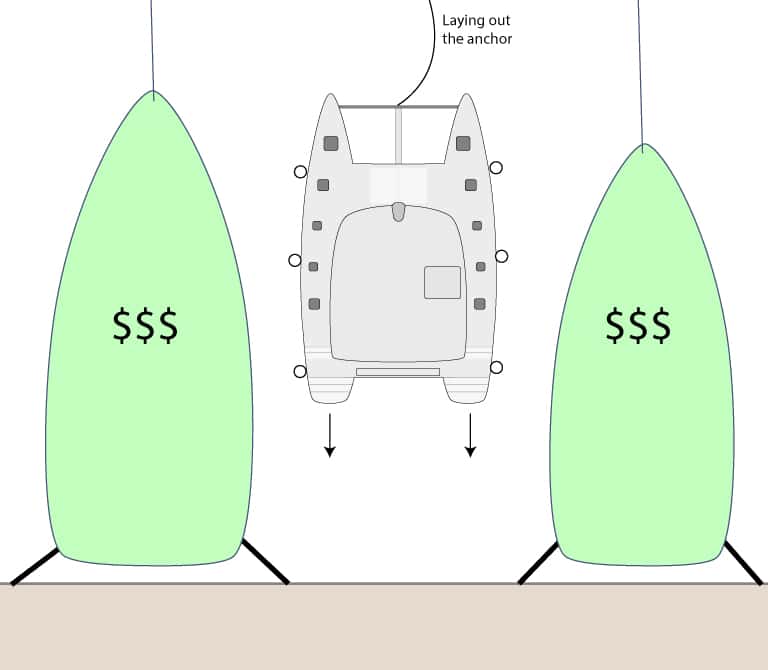
The operation is slightly trickier than using the slime lines because of several factors.
- There is a slight amount of stress. You can’t allow the anchor to slip in the night otherwise your stern will bang and scrape into an unforgiving concrete wall.
- Communication between the anchorperson and the helm is often difficult. Consider putting a person midway between to relay. Also, decide ahead of time what key hand signals to use.
- The anchor person must be quite skilled:
- The anchorperson has several things to monitor: the rate of water moving under the boat vs the speed of letting out the anchor chain through the windlass, watching the skipper for signals, and how close the boat is to the dock.
- They cannot let out the anchor chain slower than the boat’s speed else the anchor will drag along the bottom as the boat reverses. Many times, the anchor person must signal the helmsperson to slow down.
- They cannot let out the anchor chain too fast, otherwise the anchor person will be unable to hold the boat off the quay when it comes time to stop at the quay.
- The anchorperson has several things to monitor: the rate of water moving under the boat vs the speed of letting out the anchor chain through the windlass, watching the skipper for signals, and how close the boat is to the dock.
- You need to drop the anchor far enough out to get the anchor rode scope correct – for all chain rode, you should let out 50 ft (15m) plus 2 times the depth. BUT unlike regular anchoring where you just keep backing until you get the right scope, with a quay in the way you have to gauge the distance to the quay and compare that to the depth where you are dropping the hook. To gauge this, use boat lengths as a measurement of distance.
- First survey the area with a depth sounder to determine depths then find a point out from the quay where the depth in boat lengths matches the rode length formula. e.g. suppose you are in a Lagoon 45 and the depth is 45 feet (14 m) (50+2×90 = 140 ft)(15+2×14=43m) that’s 3 times the length of your boat. BUT remember your bow will stop a boat length out from the quay so add another boat length. Thus eyeball 4 boat lengths to the quay. If 4 boat lengths out from the quay match 45 ft deep, then you’re in a good place to drop.
- Always use more than 50 ft (15m) + 2 x depth and never use less. e.g. if in the example above you were 5 boat lengths out at 45 ft (14m) then that is still good. But also know the total length of chain available. i.e. 4 boat lengths is 180 ft (55m) of chain – most boats will only have about 150 ft (45m).
- Another example is shown below: at about 3 boat lengths out from the quay the depth is 25 ft (8m). The formula says 50 ft + 2 x 25 = 100 ft (15m + 2 x 8 = 31m). This is 2 boat lengths (plus 1 for the bow to the quay distance). Thus 3 boat lengths for a 45 ft (14 m) boat works.
- First survey the area with a depth sounder to determine depths then find a point out from the quay where the depth in boat lengths matches the rode length formula. e.g. suppose you are in a Lagoon 45 and the depth is 45 feet (14 m) (50+2×90 = 140 ft)(15+2×14=43m) that’s 3 times the length of your boat. BUT remember your bow will stop a boat length out from the quay so add another boat length. Thus eyeball 4 boat lengths to the quay. If 4 boat lengths out from the quay match 45 ft deep, then you’re in a good place to drop.
After a while when operating the same boat, you become familiar with your depth-to-boat length ratios. Do your own calculation for 30 ft deep and a 38 ft monohull. The answer is at the bottom of the page – but do the calculation yourself first.
Another factor is that the wind direction determines who is in control:
- If you are backing downwind to the quay, this becomes quite easy. Once the anchor is set into the bottom, the anchorperson controls the operation. Unlike regular backing downwind, the bow is not pushed around by the wind because the anchor holds the bow to the wind. The helmsperson puts the engines in low-speed reverse. The anchorperson then simply eases out the chain until the boat is close to the quay wall. The aft dock line crew then secures the dock lines and then the anchor person tightens up on the chain. The helmsperson then disengages reverse. During this operation, the anchor opposes the reverse engines and the anchor person is in control. They are simply allowing the boat to ease backward downwind.
- If you are backing upwind, the helmsperson has the control. They back up to the quay wall all the while the anchorperson is paying out the chain. Once the boat is close to the quay wall, the helmsperson asks the anchor person to tighten up to hold the boat off the quay wall. The helmsperson gauges the throttle while the aft dock line crew secures the dock lines. Once secure, the helmsperson eases the throttles and asks the anchorperson to fully tighten the anchor chain. During this operation, the reverse engines propel the boat backward against the wind. The helmsperson is in control. The anchorperson simply pays out the chain and then when the time comes, tightens the chain to keep the boat off the quay wall.
- With sidewind, the helmsperson is in control and must ferry the boat sideways to the wind to keep the boat going directly into the slip without being blown sideways downwind. To do this, the helmsperson uses the opposing throttles to twist the bow slightly downwind so that the aft is powering slightly upwind as it goes backward. This counteracts the windage slip downwind. The below image applies to monohulls and catamarans.
With the sidewind, the idea is to get the boat in as fast as possible to the quay, keeping it moving to get to the dock ferrying as needed to counteract the leeway. More than likely you are going to be skewed off and pushed downwind and probably against another boat. For this reason, prepare a long spring line from a windward amidships cleat ahead of time. As you land, get it ashore and tied directly to a far windward quay cleat as soon as possible. Now you can use rudder and forward thrust to straighten your boat out as well as spring it upwind.
The below image demonstrates this. This also works for a monohull. Make use of your rudder in a monohull. Turning the wheel to the lee to make your stern go upwind. Turn to windward to make your stern go downwind. By balancing the throttle and rudder, you can make the boat go perfectly sideways upwind and away from the Prince’s boat.
Also, view this video we shot in the MarineVerse Virtual Reality program which discusses the above (hint hint – if you want to get really good at docking, get the VR program).
Adjustments to distancing the stern from the quay wall:
- If the boat is too close to the quay, the anchorperson tightens the anchor while the aft dockline crew eases the aft dock lines.
- If the boat is too far from the quay, the helmsperson applies more reverse power while the aft dockline crew tightens the dock lines.
- If the boat does not move aft enough, the helmsperson lowers the engine revs. The anchor person then eases an amount appropriate. The helms person then applies more power in reverse.
- If in a catamaran, it is not practical to apply the catamaran bridle to the anchor chain in a med mooring situation.
Don’t mess up your perfect job
After reading the above, you’ll see that the helmsperson/anchorperson uses the anchor combined with the engines to slowly bring the boat stern to the quay wall and stop the boat at the correct approximate distance.
All too often an inexperienced helmsperson will put the boat in a mad panic forward thrust to get the boat away from touching the quay wall. First off, it never should have gotten that close and secondly, a long forward thrust will drive the boat back out of the slip into the fairway only to have the helmsperson jam the engine back in full reverse. You can see how this will quickly turn into a mess: You’ll have some crew on the dock, the dock lines will be too short to reach, and your aft crew will be throwing lines into the water while you have the prop churning away. Dock lines will get wrapped around the prop, and you’ll be half out of the slip and getting pushed against the next boat by the wind. The engine will be stalled. Everyone will be yelling at you in goodness knows what language. It will be mayhem—all because you left the forward thrust on a little too long. Become a master at stopping the boat dead and putting the throttle into neutral when needed. Use the anchor and throttle in conjunction.
Securing the Aft
Once the boat gets close to the dock wall, have some crew ready to step off (no jumping) and receive the stern lines cast to them from the crew at the aft. Many times, willing people are strolling the dock who will receive the aft dock lines. Do not expect that those people are experts. Whether it is your crew or the strollers, you must point to exactly which quay cleat to tie to. Pick cleats wide away from your beam.
For now, unless it is a dead calm day and you performed the maneuver perfectly, don’t worry about perfectly tying the aft lines. You can fix and adjust them later. The most important thing is to get the lines tied quickly to the cleat on the quay. This allows you to spring the boat back into position – if you need to – using thrust over the turned rudder.
After you are settled in, undo the knot on the quay cleat and run the line through or around the cleat and back to the boat cleat. This allows for easy release-and-go once you are ready to cast off the next day.
In the image above, the stern line runs from the boat, through a ring on the quay, and back to the boat. The thin lines are the quay-end to the slime lines. These are the ones you grab with your boathook and run forward to the forward cleat.
Other Mediterranean Mooring Points to Consider
- If you are going to do a Mediterranean Mooring with an anchor, make really sure that for this marina, anchoring is the way you’re supposed to do it. Because if you do it in a marina where there are other cables laid across the bottom holding docks and sunken mooring blocks in place, you will definitely get your anchor hooked on these. The absolute last thing in the world you want to do is to swim in a Mediterranean marina. Many boats in the Mediterranean pump out their heads directly into the ocean and you will definitely come down with a nasty disease.
- The key is practice. Don’t do a Mediterranean Mooring for the first time in the marina with a crosswind and traffic and million-dollar boats all around. Practice at home first. Even if you have a monohull at home, practice with the monohull because the success is with the crew and communication and the plan, not with the boat. Maneuvering the catamaran itself is easy. During practice, use a mooring ball instead of a hard dock wall to start out with.
- Doing a Med-Mooring requires some very good maneuvering skills, so we highly advise that you practice the teachings here in your home port before you head to the Med. Take the NauticEd Maneuvering Under Power course and the NauticEd Catamaran Sailing Confidence course.
- Debrief. At the end of every Med-Mooring event that you do on your sailing vacation with your relatively green landlubber crew, good or bad, do a debrief on what you all did great, how you all could have done it better, and what to do next time. Remember to keep your “good-leader” hat on. Take the blame and responsibility upon yourself first—that you could have given better instructions or you did not anticipate such and such.
- The good-leader hat. Cognitively, human brains operate at about 15% efficiency when being yelled at. If you yell, YOU are causing the problem to get worse. When situations arise, use the name of the person you want to perform the action and use slow clear instructions.
- Feel free to get innovative with dock lines. In this picture below, we show using a midships spring line. The wind was high from starboard. This windward spring line held the boat straight in the slip.
 The Perfect Landing
The Perfect Landing
In a little Greek port called Perdika, just southwest of Athens, we Med-Moored up to the quay at about 9:00 one morning. We’d just come from Aegina and decided we needed another coffee. Throughout our maneuver, the guy in the boat next to our intended parking spot kept eating his cereal from a bowl while watching and reading a book. A testament to a perfect landing.
 A Not-So-Perfect Landing
A Not-So-Perfect Landing
A few days later in Poros, we did not set the anchor out far enough in a strong crosswind. I asked the anchorperson to tighten up on the anchor because we were bow-down in the wind and had not set a windward spring line and the person on the dock tied the aft line to a leeward quay cleat (all my fault, by the way). After a while, she announced that the anchor was dangling below the bow. Whoops! As this was going on, people from everywhere had set down their drinks to help. We renamed Poros “Amateur Island” after our poorly planned and executed maneuver. Fortunately, there was no gelcoat damage—just ego damage and a good learning story aptly placed in this book.
The second time we got it right by proper preparation and using a windward amidships spring line as shown above.
Gaining Confidence
Do not let the first time you do a Mediterranean mooring be in the Mediterranean in a marina. Gain the skills and confidence at home first away from the marina. Again, a buoy is a great place to start.
 Exercise M9-2
Exercise M9-2
Pick a buoy and back up to it from a downwind position stopping the boat with the center of your stern 3ft (1 m) from the buoy. Make sure your boat is stopped in the water and you are able to maintain the 3ft (1m) distance for at least 10 seconds. This means an acute use of the throttle to stop the boat. If you find that you held the throttle on too long, perform the exercise again.
What You Learned
It is extremely difficult at first to gauge the stopping of the boat.
 Exercise M9-3
Exercise M9-3
Repeat the exercise with the wind on the port beam and again on the starboard beam, ferrying the boat as you learned.
What You Learned
The ferrying skill is important
 Exercise M9-4
Exercise M9-4
Repeat the exercise from an upwind position remembering to start with a preemptive strike on the propwalk but not so much that the wind will push the bow down.
 What You Learned
What You Learned
Starting out with the bow into the wind is difficult.
When having to Med moor from an upwind position, after you have dropped the anchor and it becomes caught, the anchor will help keep the bow into the wind.
If you are not using a bow anchor in the Med mooring situation but instead using the Corpo Morto slime line method, then you can start out with your stern to wind first until you gain enough water flow over the rudder to be able to turn the boat to reverse it downwind.
 Exercise M9-5
Exercise M9-5
In your own body of water and marina, once you are confident, perform Mediterranean moorings from all angles of wind direction.
Practical Experience
For gaining Mediterranean Mooring practical expertise, we highly recommend the Med Mooring Module in our Virtual Reality App developed with our partner MarineVerse. See this introductory video below. For access see the NauticEd Virtual Reality course.
Answer for 38 ft (12m) monohull in 30 ft (9m) – drop anchor about 4 boat lengths out.

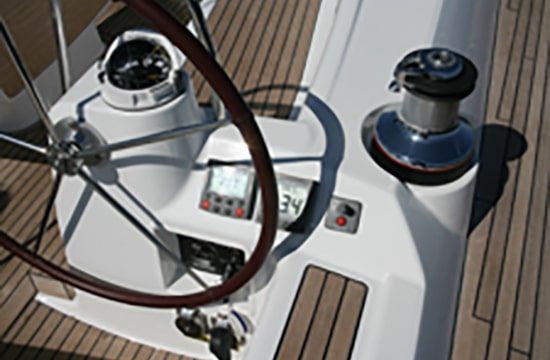
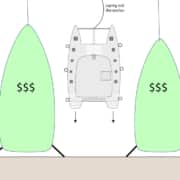
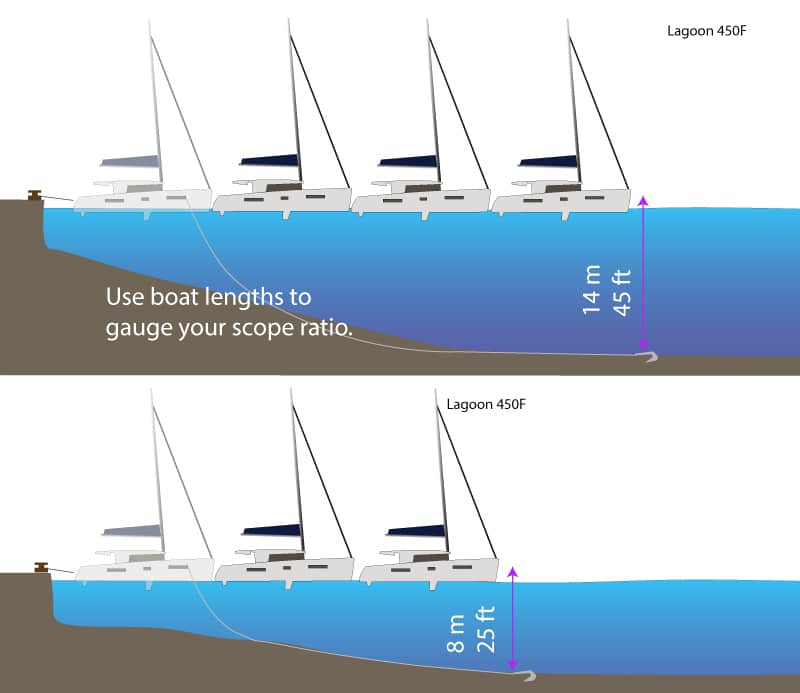
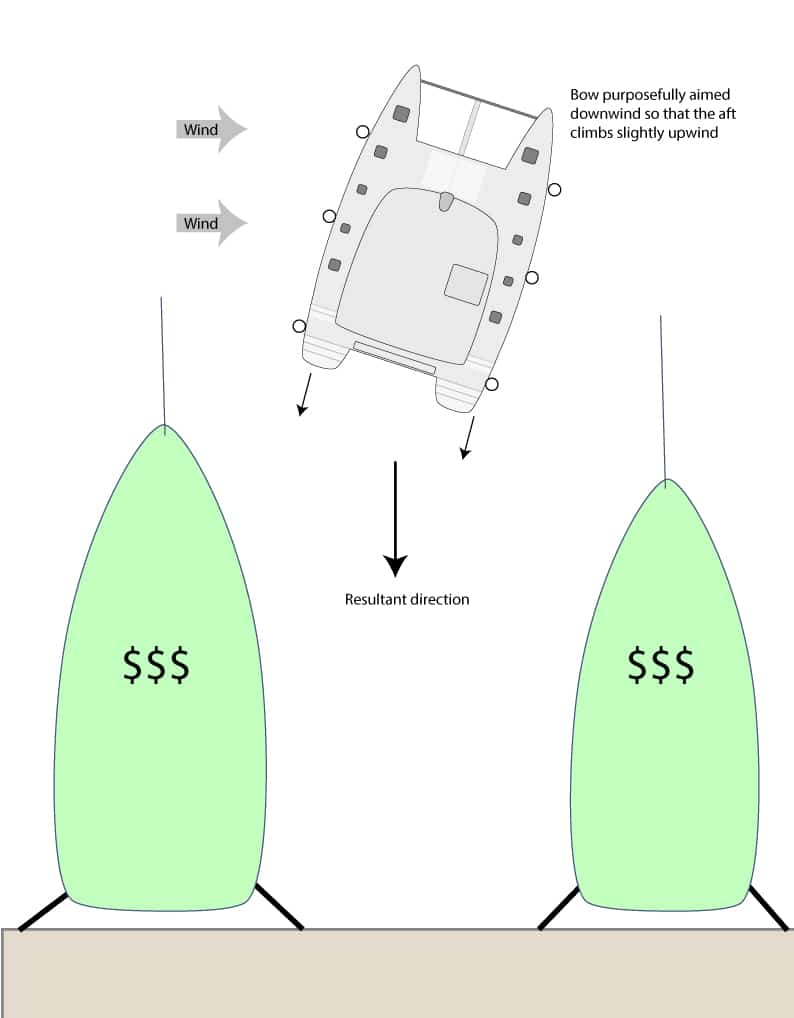
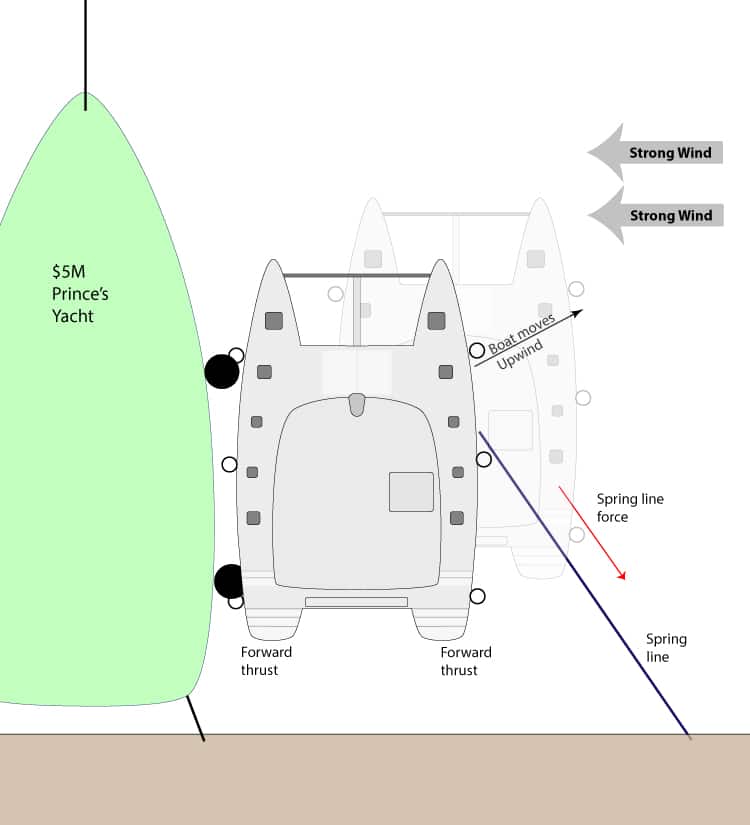
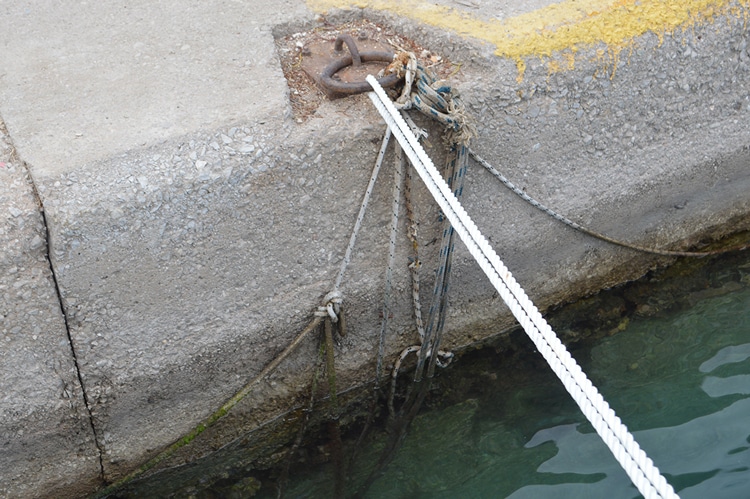
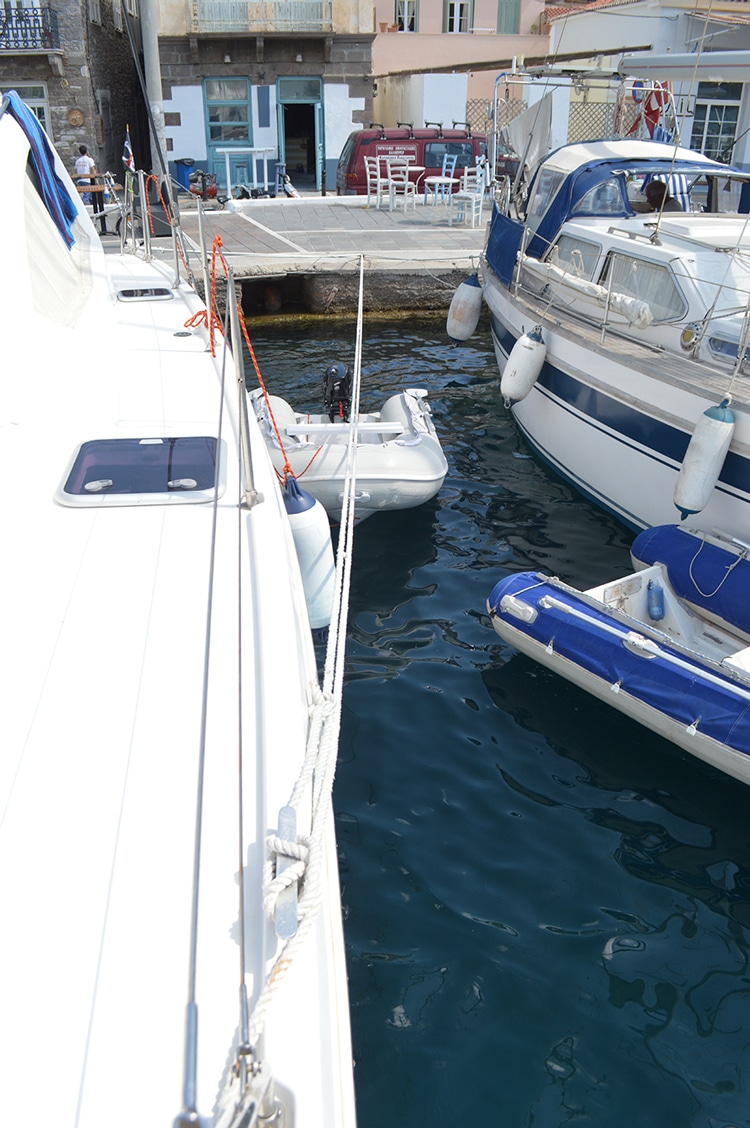
 The Perfect Landing
The Perfect Landing Exercise M9-2
Exercise M9-2



